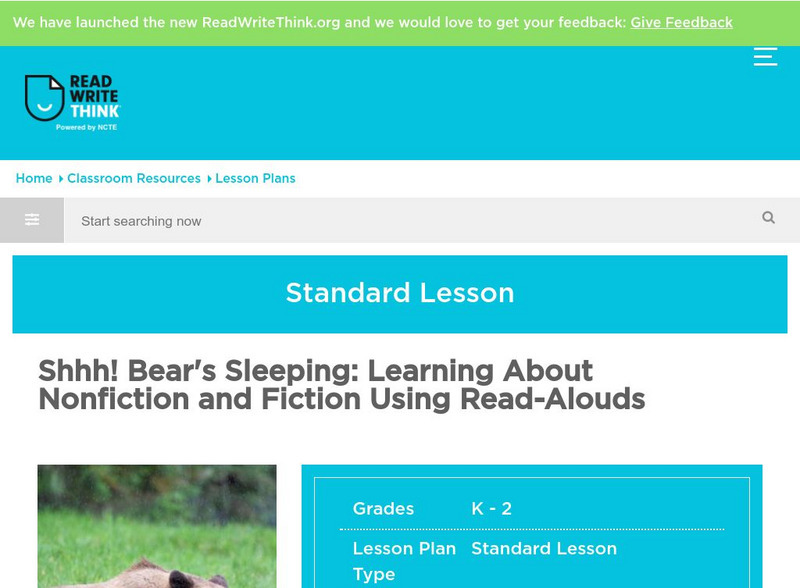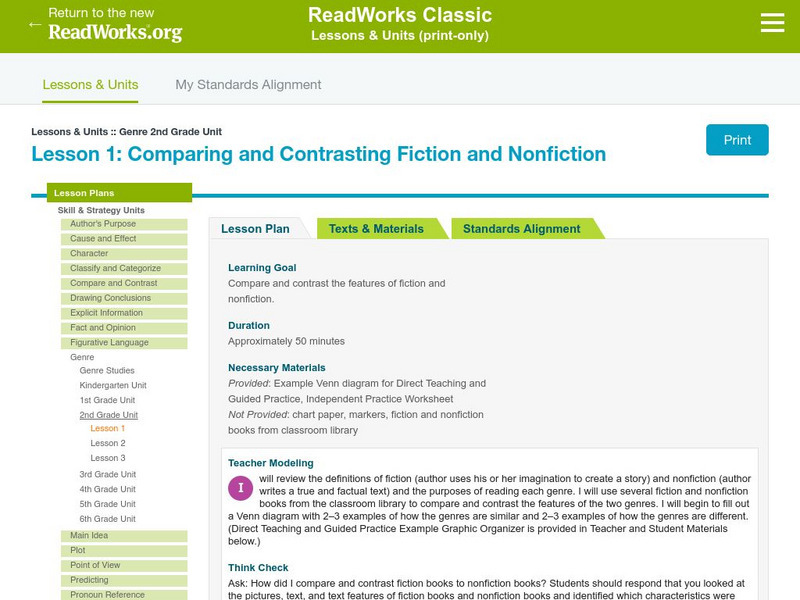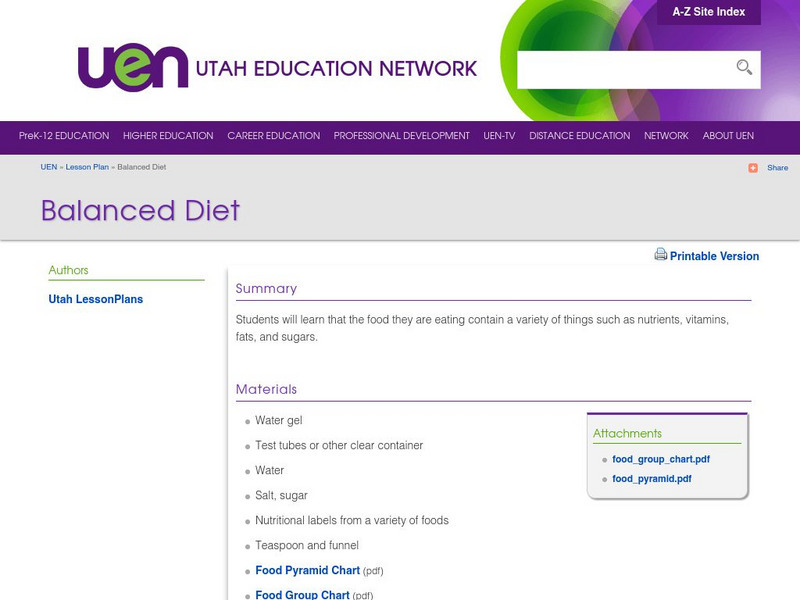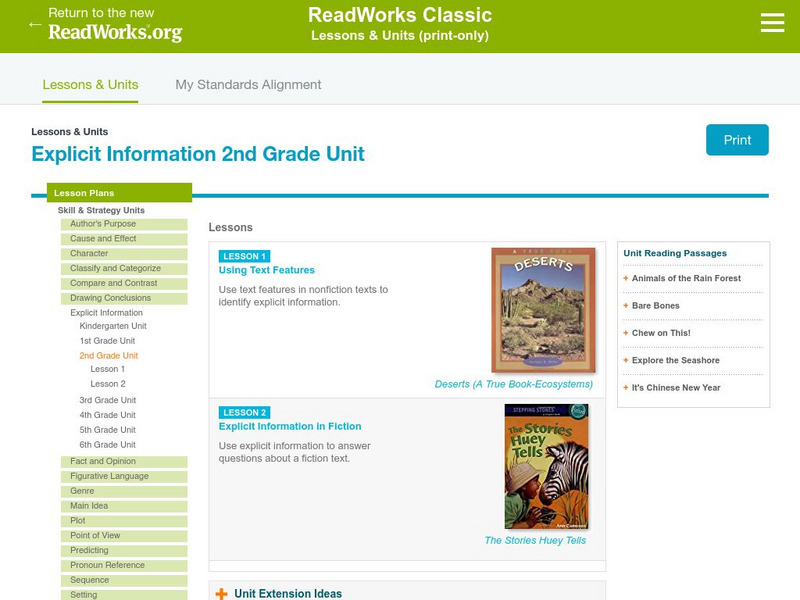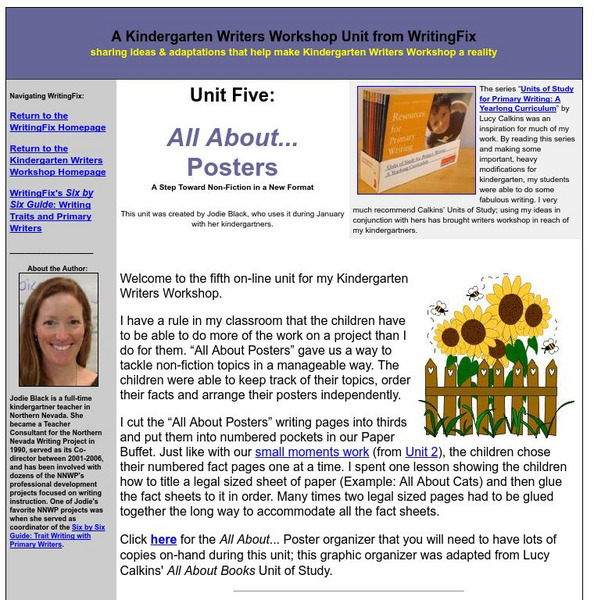British Library
British Library: 19th Century Non Fiction Texts: Gender, Behaviour & Etiquette
This thematic collection will allow young scholars to read and understand 19th-century non-fiction texts, and support them in identifying key features for a range of genres, audiences, and purposes. Each source is accompanied by original...
South Carolina Educational Television
Know It All: Non Fiction Text Features
Fifth graders will use non-fiction books to identify and explain how text features help them as individual readers.
ReadWriteThink
Read Write Think: Shhh! Bear's Sleeping: Learning About Nonfiction and Fiction
Students explore the distinction between the fiction story Bear Snores On and the nonfiction book Every Autumn Comes the Bear.
TES Global
Tes: Non Fiction Unit 4 Formal/impersonal Writing: Tourists
[Free Registration/Login Required] Young scholars will analyze tourism brochures to determine features related to nonfiction writing in this unit. Tourism websites may be used in lieu of the brochures. Cotswold and the North Leigh Roman...
National Endowment for the Humanities
Neh: Edsit Ement: Steinbeck's Use of Nonfiction Sources in "The Grapes of Wrath"
In this lesson plan, students will consider Steinbeck's Use of Nonfiction Sources in "The Grapes of Wrath". Worksheets and other supporting materials can be found under the Resources tab. In this lesson students will compare nonfiction...
TES Global
Tes: Analyzing & Comparing Non Fiction
[Free Registration/Login Required] Resource notes to aid students as they analyze different types of nonfiction. The GAP (genre, audience, and purpose) acronym is provided to use when comparing nonfiction texts.
Scholastic
Scholastic: Teaching With Nonfiction: Teach Text Features
A brief lesson plan, this site offers an example of non-fiction text and a graphic organizer to help orient students to the features they need to use when reading for information.
TES Global
Tes: Guided Reading Resources: Nonfiction
[Free Registration/Login Required] This learning module contains several guided reading resources. Students will be able to use the charts to guide themselves as they discuss informational texts and persuasive texts. Teachers can monitor...
ReadWriteThink
Read Write Think: Text Features: Non Fiction [Pdf]
Compare the printed page to an electronic web page and use this activity to discuss the similarities and differences. A cross-curricular tie-in with ecosystems. Could easily be adapted to another subject area.
Read Works
Read Works: Explicit Information 1st Grade Unit
[Free Registration/Login Required] A two-lesson unit in which learners learn how to identify explicit information in both fiction and non-fiction texts. The lessons utilize the books Frogs by Gail Gibbons and Stellaluna by Janell Cannon....
Read Works
Read Works: 2nd Grade Lesson: Compare/contrast Genres
[Free Registration/Login Required] A lesson in which students use fiction and nonfiction books from a classroom library to identify the similarities and differences between fiction and nonfiction and to create a Venn diagram...
Read Works
Read Works: 1st Grade Lesson: Classifying Texts
[Free Registration/Login Required] A lesson in which students use the books Froggy Goes to School by Jonathan London and Life Cycle of a Frog by Angela Royston to learn to classify texts as fiction or nonfiction. Lesson includes direct...
Read Works
Read Works: 1st Grade Lesson: Purposes for Reading
[Free Registration/Login Required] A lesson in which students use the books Nature's Food Chains: What Polar Animals Eat by Joanne Mattern, Life Cycle of a Frog by Angela Royston, and Froggy Goes to School by Jonathan London to learn to...
Louisiana Department of Education
Louisiana Doe: Louisiana Believes: English Language Arts: Grade 7: Excerpts From Behind the Scenes
Seventh graders explore a tumultuous period in our country's history during which people questioned political decisions, morals, and social norms. This unit presents opportunities for students to examine different perspectives through...
Utah Education Network
Uen: Balanced Diet
In this lesson, 2nd graders will learn about the components of a balanced diet. Students will analyze charts and then self-report their own foods in categories. Several fiction and nonfiction books are listed as additional resources.
ReadWriteThink
Read Write Think: Let's Build a Snowman
These two lessons that teach learners about how animals survive in the winter by reading fiction and nonfiction. In addition to objectives and standards, this instructional plan contains links to sites used in the lessons as well as...
Read Works
Read Works: Main Idea 1st Grade Unit
[Free Registration/Login Required] Students learn to use titles and supporting details in both fiction and non-fiction texts in order to identify the main idea of the book in this three-lesson unit. The lessons utilize the books Animal...
Utah Education Network
Uen: One True Story, Told Two Ways
Analyze the different perspectives presented by two authors telling the same story.
Read Works
Read Works: Grade 2: Two Lesson Unit: Explicit Information
[Free Registration/Login Required] Designed to teach students to identify explicit information in nonfiction and fiction texts. Lessons are based on the books Deserts (A True Book-Ecosystems) by Darlene R. Stille and The Stories Huey...
Writing Fix
Writing Fix: All About Posters
As young writers become more skilled through the Writers Workshop lessons, they can begin working to become more skilled with non-fiction writing. A series of mini-lessons, graphic organizers, and samples of student work are all provided.
Other
Siu Edwardsville: Professional Development Center: Lesson Plan: Inference [Pdf]
Lesson teaching the use of word selection, context, structure, and specific references in making inferences within non-fiction texts.
Alabama Learning Exchange
Alex: Play the Dewey Decimal System Game
This lesson introduces the 10 main categories used in the Dewey Decimal Classification System for non-fiction bookshelf arrangement. A slideshow will be presented to learners to help them learn details about the Dewey Decimal...
Alabama Learning Exchange
Alex: Dewey Decimal Classification System Mural
Students will select a book from an assigned section in the non-fiction area of the library. After reading the books, students will write a paragraph that summarizes the content area of the book. Students will illustrate the book that...
Austin Independent School District
Austin Independent School District:teaching Summarization to Struggling Students
A lesson designed to teach learners how to recognize an effective summary. Following the lesson, several practice fiction and nonfiction texts are available in both English and Spanish for grades 3, 4, and 5. Answer key provided. [PDF]
Other popular searches
- Genre Fiction and Nonfiction
- Fiction and Nonfiction Text
- Nonfiction and Fiction
- Fiction Nonfiction Books
- Fiction and Nonfiction Events
- Fiction vs Nonfiction Books
- Nonfiction Fiction
- Twinning Fiction/nonfiction
- Fiction or Nonfiction Unit
- Fiction vs. Nonfiction Books
- Fiction/nonfiction Books
- Identify Fiction Nonfiction

